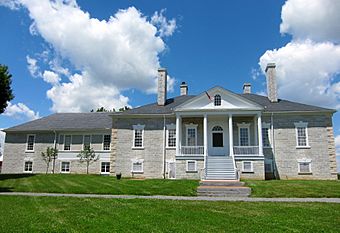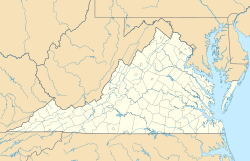Belle Grove Plantation (Middletown, Virginia) facts for kids
|
Belle Grove Plantation
|
|
|
U.S. National Historic Landmark District
Contributing Property |
|

The manor house at Belle Grove Plantation
|
|
| Location | On I-81 between Middletown and Strasburg, near Middletown, Virginia |
|---|---|
| Area | 283 acres (1.15 km2) |
| Built | 1794–97 |
| Architectural style | Federal |
| Part of | Cedar Creek Battlefield and Belle Grove (ID69000243) |
Quick facts for kids Significant dates |
|
| Designated NHLDCP | August 11, 1969 |
Belle Grove Plantation is a historic house and large estate in the northern Shenandoah Valley of Virginia, USA. It is located in Frederick County, close to Middletown. This beautiful estate was built a long time ago, in the late 1700s.
The main house, built between 1794 and 1797, is a grand building in the Federal style. It is recognized as a National Historic Landmark because of its importance. In 1967, the National Trust for Historic Preservation (NTHP) opened it to the public as a historic house museum. This means people can visit and learn about its past. Since 2002, Belle Grove has been part of the Cedar Creek and Belle Grove National Historical Park. Even though it's part of a National Park, the NTHP still owns and manages it.
Belle Grove is also a Virginia Historic Landmark. It is listed on the National Register of Historic Places as part of the larger "Cedar Creek Battlefield and Belle Grove" area, which covers about 900 acres. This place is special because it was the home of Major Isaac Hite, Jr., a hero from the American Revolutionary War. He was also the brother-in-law of President James Madison. Later, during the Battle of Cedar Creek in 1864, it served as the headquarters for General Philip Sheridan. The house has changed very little over the years, making it one of the best-preserved 18th-century homes in the country. The estate covers 283 acres and offers amazing views of the Shenandoah Valley, the Blue Ridge, and the Alleghenies.
Contents
Exploring the Belle Grove Estate
The Belle Grove Plantation has many interesting features on its grounds. These include the large limestone main house, which has a visitor's center in its basement. You can also see an icehouse and a smokehouse, both built in 1815. There is a special area called a slave cemetery and a "heritage orchard" with old fruit trees. A beautiful demonstration garden, designed by the Garden Club of Virginia, is also on the property.
Near the entrance, you'll find a monument built in 1919. It honors Stephen Dodson Ramseur, a Confederate general who passed away at the plantation in 1864 after the Battle of Belle Grove.
The Historic Manor House Exterior
The main part of the house is built in a balanced, symmetrical way. It has three levels: a basement, a main floor (called a piano nobile), and an attic. The corners of the house are decorated with special stone blocks called quoins. The front of the house, which faces south, has seven sections with windows. The main entrance is in the center. Twelve steps lead up to a grand front portico with four Tuscan-style columns. This portico covers the three central sections, with the main door in the middle. The main door is framed by two pilasters, which are like flat columns. Originally, this main part of the house had these grand porches on all four sides, but today only the front and back porches remain.
Inside the Manor House
The inside of the house is famous for its beautiful wooden details. The style of the woodwork shows a mix of older Georgian designs and newer Federal styles.
A Look at Belle Grove's Past
The story of Belle Grove begins with Jost Hite, who was Major Isaac Hite, Jr.'s grandfather. Jost was a German immigrant who came to the Shenandoah Valley in 1732. He and his partner, Robert McKay, along with 16 other families, traveled into the northern Valley. They settled on a huge amount of land, about 140,000 acres, that they had received through land grants.
One of Jost's sons, Isaac Hite, Sr., bought 300 acres in 1748 and another 183 acres in 1770. These lands, located southwest of Middletown, would later become the Belle Grove Plantation. The first house on the Belle Grove property was a large limestone building. It was built around 1750 for a farmer who rented the land. You can still see its old foundations near the smokehouse today.
Isaac Hite, Jr. went to the College of William & Mary. He fought in the Continental Army during the American Revolutionary War. In 1783, when Isaac, Jr. married Nelly Conway Madison, his father gave them the 483-acre Belle Grove property. Nelly was the sister of James Madison, who would later become President of the United States.
Construction on the new, larger mansion began in 1794 and took three years to finish. It was built using local limestone from the property itself. Building a grand house like this was a way for owners to show their high social and financial standing. Thomas Jefferson, a famous American leader, even gave suggestions for the house's design through his friend James Madison. James Madison visited the plantation several times, even staying in the "Old Hall" during his honeymoon in 1794, before the new mansion was completed.
After Nelly passed away in 1802, Major Hite married Ann Tunstall Maury. He had three children with Nelly and ten with Ann, and almost all of them lived to be adults. In 1815, an addition was built on the west side of the house, making it the 100-foot-long building we see today. As Major Hite's farms grew, he expanded his estate to include 7,500 acres of land and 103 enslaved workers. He also owned and ran a general store, a grist-mill (for grinding grain), a saw-mill, and a distillery.
After Major Hite passed away in 1836, and Ann in 1851, Belle Grove Plantation was sold outside of the family. By the time the Civil War began, the estate was no longer as it had been during the Hite family's time. Several owners came and went before the Brumback family bought the property in 1907. The Brumbacks ran an inn there in the 1920s.
In 1929, Francis Welles Hunnewell from Wellesley, Massachusetts, bought the property. These 20th-century owners changed the house very little. With help from experts, Mr. Hunnewell carefully restored the house in the 1930s and 1940s. When he passed away in 1964, he left the house, 100 acres of land around it, and money to the National Trust for Historic Preservation. Belle Grove opened as a house museum in 1967. It has been open to the public ever since, and it continues to be a working farm.
More to Explore
- Jeffersonian architecture
- Mary Briscoe Baldwin


